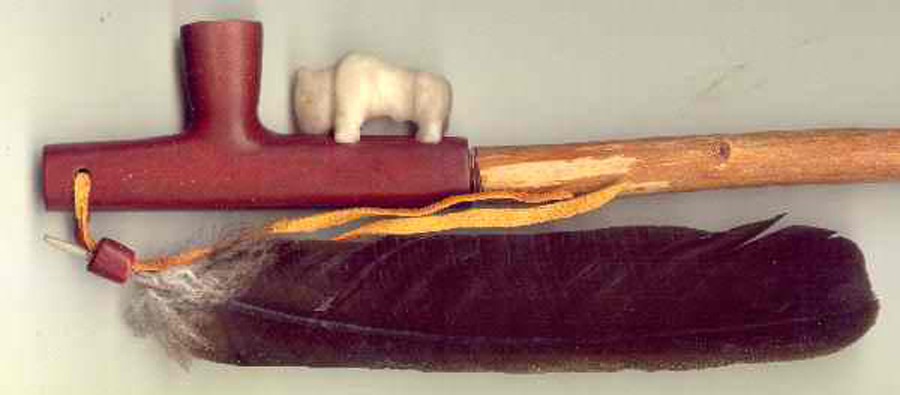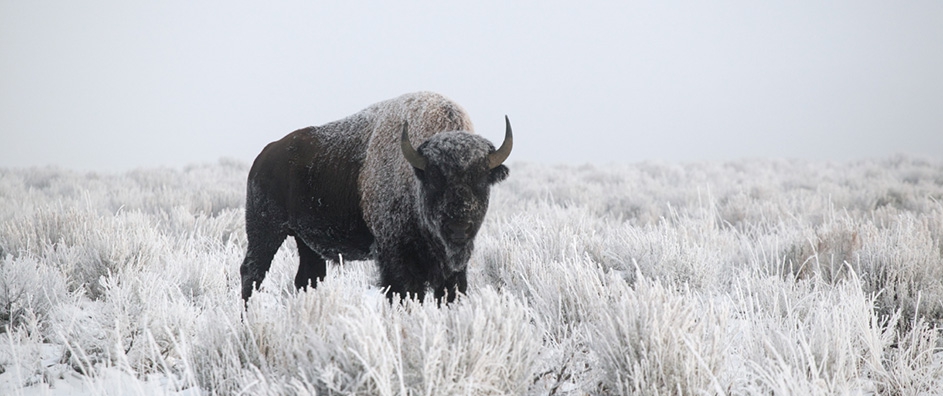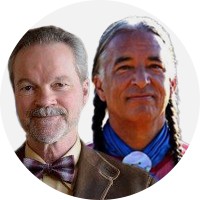The views expressed in our content reflect individual perspectives and do not represent the authoritative views of the Baha'i Faith.
…Man is dual in aspect: as an animal he is subject to nature, but in his spiritual or conscious being he transcends the world of material existence. His spiritual powers, being nobler and higher, possess virtues of which nature intrinsically has no evidence; therefore, they triumph over natural conditions. These ideal virtues or powers in man surpass or surround nature, comprehend natural laws and phenomena, penetrate the mysteries of the unknown and invisible and bring them forth into the realm of the known and visible. – Abdu’l-Baha, The Promulgation of Universal Peace, p. 81.
Kevin and I had a fascinating hour-long conversation that inspired a question, based on this sacred Lakota tradition:
A council was called and two young men were selected to go in quest of buffalo and other game. They started on foot. When they were out of sight, they each went in a different direction, but met again at a place which they had agreed upon. While they were planning and planning what to do, there appeared from the west a solitary object advancing toward them. It did not look like a buffalo; it looked more like a human being than anything else. They could not make out what it was, but it was coming rapidly.
Both considered themselves brave, so they concluded that they would face whatever it might be. They stood still and gazed at it very easily. At last they saw that it was a beautiful young maiden. She wore a beautiful fringed buckskin dress, leggings, and moccasins. Her hair was hanging loose except at the left side, where was tied a tuft of shedded buffalo hair. In her right hand she carried a fan made of flat sage. Her face was painted with red vertical stripes. Not knowing what to do or say, they hesitated, saying nothing to her…
While she was thus speaking to the young men, one of them had impure thoughts. A cloud came down and enveloped this young man. When the cloud left the earth, the young man was left there—only a skeleton. The Maiden commanded the other young man to turn his back toward her and face in the direction of the east, then to start for home. He was ordered not to look back. – Iśna´la-wića´(“Lone Man”) translated by Robert P. Higheagle, qtd. in Frances Densmore, Teton Sioux Music (1918), pp. 64–65.
(Chris): Kevin, you told me that the two scouts who met White Buffalo Maiden were actually one person, and that the scout who “had impure thoughts” about the heavenly Maiden actually represented the “animal nature,” while the scout with the spiritual nature had the bounty of receiving White Buffalo Maiden’s teachings.
(Kevin): From my reading of the Baha’i Writings, I began to ponder certain points about the narrative of the coming of White Buffalo Maiden (“White Buffalo Woman” or “White Buffalo Calf Woman” or “White Buffalo Calf Maiden”): The people were starving. The starvation was a direct result of the people’s having fallen away from the Sacred Teachings, Laws and Covenant resulting in internal strife, conflict and disunity leading to disastrous imbalance with the physical world. I began to wonder how the surviving scout could have been influential enough to fulfill the White Buffalo Maiden’s command to convene an assemblage to hear the Maiden’s Sacred Teachings, Laws and Covenant if the tribe was so disunified.
My personal conclusion was that, even though the narrative explicitly states there were two scouts, these two scouts really symbolize the dual nature in man. One represents the part in all of us that longs to soar into the spiritual realms — our eternal ascendant nature. The other scout symbolizes the ego, the insistent self — the part of us that is appetitive, materialistic and continually ensnares us in the trappings and desires of this fleeting mortal life.
When this one scout came into contact with White Buffalo Maiden — the embodiment of all that is heavenly and holy — the Maiden’s celestial presence conquered and subdued his lower nature and galvanized and transformed his spiritual reality, empowering him to fulfill the Maiden’s command to convene the gathering that would hear and respond to her message. Without this transformation, this one scout would have been impotent and powerless.
(Chris): Do the sacred songs traditionally said to have been given by White Buffalo Maiden enshrine Lakota spiritual teachings?
(Kevin): Yes. Even though the lyrics are terse, they are laden with layers of meaning. The songs don’t have names. But one can identify them by the context in which White Buffalo Maiden sang them:
- Song of the White Buffalo Maiden.
- Pipe Loading Song.
- Prayer Song.
- Four Directions Song.
I heard this ordering of the songs in the 1970s at a gathering of Medicine Men convened by Siŋté Glešká University held in St. Francis on the Rosebud Reservation. I have never heard this ordering repeated or affirmed by anyone else or at any other time. It should be emphasized that, although some may ascribe certain songs directly to White Buffalo Maiden (as in the above four songs), generally people agree that all of the “wakȟáŋ olówaŋ” (Sacred Songs) are inspired and reflective of the spiritual dispensation associated with the Maiden.

Traditional Lakota pipe decorated with a White Buffalo
(Chris): In our first article, you interpreted some of the sacred teachings enshrined in the “Song of the White Buffalo Maiden.” Can you comment on the wisdom and principles set forth in the “Pipe Loading Song”?
Pipe Loading Song
Kȟolá, léčhel ečhúŋ wo!
Kȟolá, léčhel ečhúŋ wo!
Kȟolá, léčhel ečhúŋ wo! aéj
Héčhanuŋ kiŋ, nitȟúŋkašila
waŋníyaŋg ú kte ló. aéj új
Friend, do it in this way.
Friend, do it in this way.
Friend, do it in this way.
When (if) you do that, your Grandfather
will come to see you.
Hóčhoka waŋží ogná ílotake čiŋ,
míksuya opáǧi yo! aéj
Héčhanuŋ kiŋ, táku ehé kiŋ,
iyéčhetu kte ló. aéj új
If you sit down inside the sacred circle/altar.
Remember me.
When you do that, then the things you say
will come true.
Čhaŋnúŋpa waŋží yuhá ílotake čiŋ,
míksuya opáǧi yo! aéj
Héčhanuŋ kiŋ, táku yačhíŋ kiŋ,
iyéčhetu kte ló. aéj új
If you sit down with a pipe.
Remember me.
When you do that, then the things you want
will come true.
Kȟolá, léčhel ečhúŋ wo!
Kȟolá, léčhel ečhúŋ wo!
Kȟolá, léčhel ečhúŋ wo! aéj
Héčhanuŋ kiŋ, nitȟúŋkašila
waŋníyaŋg ú kte ló. aéj új
Friend, do it in this way.
Friend, do it in this way.
Friend, do it in this way.
When (if) you do that, your Grandfather
will come to see you.
[The above transcription that I am using here is in SLO Standard Lakota Orthography, a writing system (developed by the Lakota Language Consortium) that represents each phoneme accurately and consistently.]
(Chris): I’m curious as to the true meaning of this remarkable promise, “When you do that, then the things you want will come true.”
(Kevin): This song is a wonderful expression of the Sacred Teachings, Laws and Covenant articulated by the White Buffalo Maiden. These spiritual teachings transformed the people to the extent that White Buffalo Maiden renamed them. Formerly the people (who were my ancestors) called themselves “Pte Oyáte” (“Buffalo Nation”) or “Ikčé Oyáte” or (“Common People”). White Buffalo Maiden renamed them “Lakȟóta” and commanded them to follow “Lakȟól Wičhóȟ’aŋ.” In other words, “the People of Peace.” Not the peace that occurs because of the cessation of war, but the peace and order we observe in the natural world which is a manifestation of spiritual reality; the Message that would enable humankind to reflect heavenly beauty, balance and harmony. In her song, White Buffalo Maiden exhorts the people to behave, act, and do things in this essentially sacred way.
















Comments
Sign in or create an account
Continue with Googleor